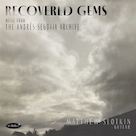

Matthew Slotkin: Recovered Gems: Music From the Andrés Segovia Archive
Summit Records
Recovered Gems: Music From the Andrés Segovia Archive has immense significance for not only musical reasons but historiographical ones too. As per the title, the recording features performances by guitarist Matthew Slotkin of solo works from the Segovia Archive; however, many are compositions that were written for the Spanish guitarist but that he did not perform during his lifetime for a variety of reasons. While the French composer Henri Martelli, for instance, wrote his Quatre pièces for Segovia in the early 1930s, the material lay unknown and unseen until its discovery seventy years later.
Slotkin, an Associate Professor of Music at Commonwealth University's Bloomsburg campus who's directed its guitar program since 2004, draws for the fifty-four-minute recording from the manuscripts published by the Italian guitarist Angelo Gilardino, who edited, sorted, and catalogued the materials at the Andrés Segovia Foundation in Linares, Spain in 2001. As only a modest number of recordings have been produced of most of these works, Slotkin's, featuring music by Martelli, Lennox Berkeley, Pierre de Breville, Pierre-Octave Ferroud, Aloÿs Fornerod, Raymond Petit, Fernande Peyrot and Cyril Scott, assumes enhanced value as a result. In making these lesser-known solo guitar pieces available, Recovered Gems amplifies one's appreciation for Segovia, naturally, but also Slotkin for both his scholarship and artistry.
Many pf the works were written during the time of Segovia's tours of Europe in the 1920s and ‘30s, and, in fact, his debut performance in Paris in 1924 engendered the creation of many new works from major composers of the time, some of which appear on Slotkin's release. In fact, the opening piece by Berkeley, Quatre pièces, stems from that period, as the composer was in Paris at the time and was studying composition with Nadia Boulanger when he saw Segovia perform. The material engages from the outset when its bright opening movement bookends a probing central episode with triple-metre passages, all of it articulated splendidly by Slotkin. Ruminative by comparison, the second movement deftly blends picking, chords, and strums into a harmonically adventurous statement, after which the third, a slow and dreamy sarabande, invites reflection as it wends its way through minor-key and improvisatory episodes. The closing “Allegro, energico” lives up to its billing with a fluid flow of eighth-note arpeggios.
Though Swiss composer Fornerod wrote his Prélude, op. 13 for Segovia in 1926-27, the guitarist Segovia never performed the piece, which prompted the composer to later recast the material as a solo piano work. It's hard to understand why Segovia didn't perform it when the material is so effective in Slotkin's presentation; remarkable too is how naturally the writing suits the guitar when it was Fornerod's only composition for the instrument. Believed to have been written in the ‘30s when Segovia lived in Geneva, Peyrot's Thème et variations was first discovered at the 2001 opening of the Segovia Archive and builds on its sober theme with six evocative and contrasting variations, some spirited and others gentle and introspective. Martelli's Quatre pièces advances from the contrapuntal breeziness of the “Gaiement” movement to the rapidly flowing “Vite,” the gentle “Lent,” and dance-inflected “Animé.”
After encountering Segovia in Paris in the 1920s, French composer de Breville created his untitled solo guitar work, here titled Fantaisie, in 1926. The six-minute setting comprises three distinct sections, a rhythmically robust start, a soothing central passage, and finally a reinstatement of energetic flow. Similarly, Ferroud met Segovia after one of his Paris concerts in 1926 and subsequently wrote the charming Spiritual; not the only time it happened, the guitarist never performed it, which led the composer to eventually re-present it in piano duet and orchestral versions. When French composer Petit wrote Sicilienne for Segovia, he included the wry dedication “to Andrés Segovia, if he does not find it too ugly” on the score. The guitarist did, in fact, perform it, and why wouldn't he when it possesses such enticing melodic content, clarity of expression, and tonal appeal.
The album closes memorably with Slotkin's rendering of Scott's three-part Sonatina, the composer's only work for guitar. Written in 1927, its first movement was performed a year later by Segovia under the title “Rêverie,” but in a letter to the Mexican composer Manuel Ponce the guitarist disparaged the piece. The damning assessment is puzzling when the exotic opening movement strikingly employs sliding parallel chords and connecting single-note threads. Whereas the shorter central movement perpetuates the tone and character of the opening, the “Finale” is predictably livelier in its use of strums, chords, and off-kilter rhythms.
As stated, Recovered Gems is significant for presenting rarely heard and little-recorded pieces written for Segovia but also for showcasing the guitar artistry of Slotkin, who some might also know from the two recordings he's issued on Summit Records with double bassist Craig Butterfield under the Dez Cordas name. While always deployed in service to the music, Slotkin's consummate technique is clearly evident on the Segovia set, and the clarity of his articulation and nuanced handling of dynamics and texture markedly enhance the presentation too.May 2025